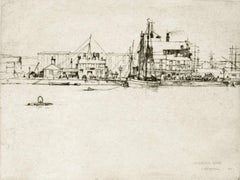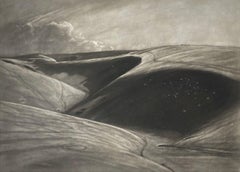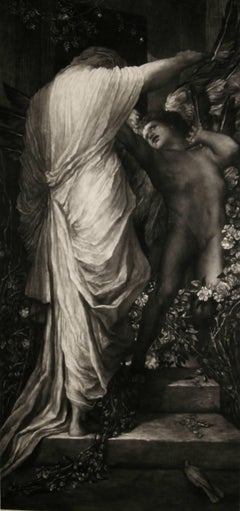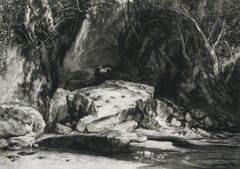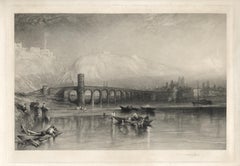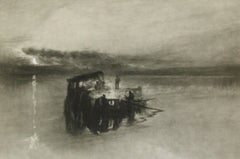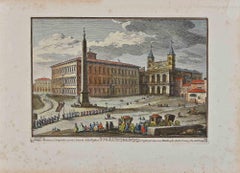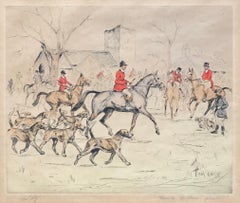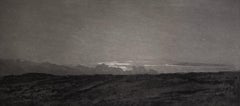Sir Frank Short Art
British, 1857-1945
Sir Francis Job "Frank" Short PPRE (19 June 1857 - 22 April 1945) was a British printmaker and teacher of printmaking. He revived the practices of mezzotint and pure aquatint while expanding the expressive power of line in drypoint etching and engraving. Short also wrote about printmaking to educate a wider public and was President of the Royal Society of Painter Etcher & Engravers (now styled the Royal Society of Painter-Printmakers) from 1910 to 1938. Short was elected to the Royal Academy in 1911, the same year he was knighted, and served as the R.A.'s Treasurer from 1919-1932. He was also President of the Royal Society of Painter-Etchers and Head of the Engraving School of the Royal College of Art, where he taught from 1891-1924.to
5
13
8
8
5
4
3
2
2
1
1
1
George's Dock, LIverpool.
By Sir Frank Short
Located in Storrs, CT
1890. Etching. Hardie 245. 5 7/8 x 7 3/4 (sheet 8 1/4 x 10 1/8). Two hinge stains in the top sheet edges; otherwise excellent condition. A rich impression with plate tone, printed on cream wove paper with full margins. Signed in pencil. Housed in a 16 x 20-inch archival mat.
--------------------------------------------------------------------------------------
George's Dock was located on the River Mersey, England, within the Port of Liverpool. It was connected to Canning Dock to the south and George's Basin to the north. The dock, which opened in 1771, was designed and built by Henry Berry and expanded by John Foster, Sr.
In 1899 the dock and the adjoining George's Basin were filled in to create what is now the Pier Head...
Category
19th Century Modern Sir Frank Short Art
Materials
Etching
The Shadowed Valley.
By Sir Frank Short
Located in Storrs, CT
Sir Frank Short, R.A., P.R.E. 1857-1945. The Shadowed Valley. 1927. Mezzotint. Hardie 128. 14 3/8 x 19 3/8 (sheet 19 x 24). A rich, glowing impression p...
Category
1920s Modern Sir Frank Short Art
Materials
Mezzotint
$2,750 Sale Price
38% Off
Love and Death.
By Sir Frank Short
Located in Storrs, CT
Love and Death (after George Frederic Watts, R.A., H.R.C.A. 1817 - 1904). 1900. Mezzotint. Hardie 71 between i and ii. 24 1/2 x 12 (sheet 27 1/4 x 13 3/ 8). Edition 350 in state one. London, Published May 1st 1900 by Robert Dunthorne ,5 Vigo Street, London W. Rubbing and discoloration from a previous mat in the margins, well outside the image. A rich proof printed on Japon paper. Signed in pencil by Watts and by Short. Housed in an archival folder
-------------------------------------------------------------------------------------------------------
Winged Love...
Category
Early 1900s Victorian Sir Frank Short Art
Materials
Mezzotint
$1,000 Sale Price
33% Off
A Yorkshire Dell or The Heron’s Pool.
By Sir Frank Short
Located in Storrs, CT
A Yorkshire Dell or The Heron’s Pool. (after J.M.W. Turner, R.A., 1775-1851.) Soft-ground etching and mezzotint. Hardie 85. mezzotint over etching on India paper printed on chine-co...
Category
Early 20th Century Romantic Sir Frank Short Art
Materials
Mezzotint, Etching
$1,000 Sale Price
20% Off
J. M. W. Turner / Sir Frank Short mezzotint "Erhrenbreitstein to Coblenz, No. 2"
By Sir Frank Short
Located in Henderson, NV
Medium: mezzotint. Catalogue reference: Hardie 95. Executed in 1913 by Sir Frank Short after J. M. W. Turner and signed in pencil by Sir Frank Short. Printed on chine-collé paper in ...
Category
1910s Sir Frank Short Art
Materials
Mezzotint, Etching
Timber Raft on the Rhine
By Sir Frank Short
Located in Storrs, CT
Timber Raft on the Rhine (after the watercolor by J.M.W. Turner in the National Gallery). 1898. Mezzotint. Hardie 66. 8 1/4 x 11 11/16 (sheet 10 5/16 x 13 1/2). Edition 100. A rich, ...
Category
1890s Romantic Sir Frank Short Art
Materials
Mezzotint
"Strand Gate, Winchelsea" signed original etching
By Sir Frank Short
Located in Henderson, NV
Medium: original etching and drypoint. Catalogue reference: Hardie 367. Signed in pencil. Executed in 1910, this is a nice impression with plate tone printed on laid paper. Plate siz...
Category
1910s Sir Frank Short Art
Materials
Etching
Twixt Dawn and Day
By Sir Frank Short
Located in Storrs, CT
Twixt Day and Dawn. 1919. Aquatint. Hardie catalog 165 state ii. Image 9 7/8 x 11 1/2 (sheet 13 9/16 x 16 7/8). A masterly inked impression produces subtle lighting variations throu...
Category
Early 20th Century Modern Sir Frank Short Art
Materials
Aquatint
$500 Sale Price
39% Off
Cottage and Harvesters
By Sir Frank Short
Located in Storrs, CT
Cottage and Harvesters (after a watercolor by Peter De Wint, 1784-1849). 1907. Mezzotint. Hardie 88. 6 5/8 x 10 11/16 (sheet 14 x 19 1/4). Edition 100. Housed in a 16 x 20 mat. A ver...
Category
Early 1900s Romantic Sir Frank Short Art
Materials
Mezzotint
Water Mill
By Sir Frank Short
Located in Storrs, CT
Water Mill (after the drawing by J.M.W. Turner, R.A., 1775-1851). 1885. Mezzotint. Hardie 3.ii. With the publication line. 7 x 10 1/8 (sheet 12 1/4 x 16 5/8...
Category
1880s Sir Frank Short Art
Materials
Mezzotint
Scene in the Campagna
By Sir Frank Short
Located in Storrs, CT
Scene in the Campagna, also known as Woman at a Tank and Hindu Ablutions. (after the drawing by J.M.W. Turner, R.A., 1775-1851.) 1886. Hardie 4.ii. Mezzotint. 8 1/2 x 11 3/8 (sheet 1...
Category
1880s Sir Frank Short Art
Materials
Mezzotint
Knaresborough
By Sir Frank Short
Located in Storrs, CT
Knaresborough (after a watercolor by Peter De Wint, 1784-1849). c. 1904. Mezzotint. Hardie catalog 80 state ii. 7 7/16 x 11 3/8 (sheet 13 3/8 x 18). A very rich impression, printed o...
Category
Early 1900s Impressionist Sir Frank Short Art
Materials
Mezzotint
Rough Weather at Blatchington Pulling in the Fishing Nets on the English Coast
By Sir Frank Short
Located in Soquel, CA
Drypoint etching rawing of a coastal scene with figures drawing a net or boat form the sea by Sir Francis (Frank) Job Short (British, 1857 - 1945)
Sir Frank Short, Royal Academy*, was a printmaker and teacher of printmaking. He revived the practices of mezzotint* and aquatint* engraving, and also wrote about printmaking to educate a wider public.
Signed "Frank Short" lower right with monogram in the print "S within a shield"
Titled lower left "Rough Weather at Blatchington"
Lower left "Trial Proof"
Image, 8.5"H x 10.88"W
Mat, 16"H x 20"W x 0.13
Professionally cleaned and ph nuetral washed by our paper conservator. (new images posting)
Francis Job Short was born on 19 June 1857 in Britain, at Stourbridge, Worcestershire. He was educated to be a civil engineer.
He was engaged on various works in the Midlands until 1881, when he came to London as assistant to Mr Baldwin Latham in connection with the Parliamentary Inquiry into the pollution of the river Thames. In 1883 he was elected an associate member of the Institution of Civil Engineers. Having worked at the Stourbridge School of Art in his early years he joined the South Kensington School of Art*, in 1883. He also worked at the life class under Professor Fred...
Category
1870s Impressionist Sir Frank Short Art
Materials
Rag Paper, Drypoint, Etching, Gouache
Related Items
Piazza di San Giovanni in Laterano - Etching by Giuseppe Vasi - 18th century
By Giuseppe Vasi
Located in Roma, IT
Piazza di San Giovanni in Laterano is an original etching of the Late 18th century realized by Giuseppe Vasi.
Signed and titled on plate lower margin.
Good conditions and aged mar...
Category
18th Century Modern Sir Frank Short Art
Materials
Etching
$1,175
H 11.82 in W 16.54 in D 0.04 in
Hounds Gentlemen Please by Tom Carr - Engraving 26x31 cm
Located in Geneva, CH
Work on paper
Ed: 63/75
Category
Mid-20th Century Realist Sir Frank Short Art
Materials
Engraving
$360 Sale Price
28% Off
H 10.24 in W 12.21 in D 0.08 in
Engraving of a British Fox Hunting Scene "The Pink Of Condition"
By George Wright
Located in Alamo, CA
The engraving "The Pink Of Condition" by George Wright was published in London in 1909. It depicts the beginning of a British fox hunting scene. The ...
Category
Early 1900s Naturalistic Sir Frank Short Art
Materials
Engraving
$860 Sale Price
20% Off
H 23.63 in W 28.75 in D 0.88 in
Destinations (Flatiron Bidg, 5th Avenue and Broadway at 23rd Street)
By Frederick Mershimer
Located in New Orleans, LA
In "Destinations", Frederick Mershimer creates an image of taxis rushing by the Fuller Building, better known as Flatiron Building. The building is only six feet wide at its rounded...
Category
1990s Contemporary Sir Frank Short Art
Materials
Mezzotint, Aquatint
$2,500
H 11.57 in W 9.63 in
19th century color lithograph figures cemetery willow tree memorial headstone
By Nathaniel Currier
Located in Milwaukee, WI
The present hand-colored lithograph was produced as part of the funeral and mourning culture in the United States during the 19th century. Images like this were popular as ways of remembering loved ones, an alternative to portraiture of the deceased. This lithograph shows a man, woman and child in morning clothes next to an urn-topped stone monument. Behind are additional putto-topped headstones beneath weeping willows, with a steepled church beyond. The monument contains a space where a family could inscribe the name and death dates of a deceased loved one. In this case, it has been inscribed to a young Civil War soldier:
William W. Peabody
Died at Fairfax Seminary, VA
December 18th, 1864
Aged 18 years
The young Mr. Peabody probably died in service for the Union during the American Civil War. Farifax Seminary was a Union hospital and military headquarters in Alexandria, Virginia. The hospital served nearly two thousand soldiers during the war time. Five hundred were also buried on the Seminary's grounds.
13.75 x 9.5 inches, artwork
23 x 19 inches, frame
Published before 1864
Inscribed bottom center "Lith. & Pub. by N. Currier. 2 Spruce St. N.Y."
Framed to conservation standards using 100 percent rag matting and TruVue Conservation Clear glass, housed in a gold gilded moulding.
Nathaniel Currier was a tall introspective man with a melancholy nature. He could captivate people with his piercing stare or charm them with his sparkling blue eyes. Nathaniel was born in Roxbury, Massachusetts on March 27th, 1813, the second of four children. His parents, Nathaniel and Hannah Currier, were distant cousins who lived a humble yet spartan life. When Nathaniel was eight years old, tragedy struck. Nathaniel’s father unexpectedly passed away leaving Nathaniel and his eleven-year-old brother Lorenzo to provide for the family. In addition to their mother, Nathaniel and Lorenzo had to care for six-year-old sister Elizabeth and two-year-old brother Charles. Nathaniel worked a series of odd jobs to support the family, and at fifteen, he started what would become a life-long career when he apprenticed in the Boston lithography shop of William and John Pendleton.
A Bavarian gentleman named Alois Senefelder invented lithography just 30 years prior to young Nat Currier’s apprenticeship. While under the employ of the brothers Pendleton, Nat was taught the art of lithography by the firm’s chief printer, a French national named Dubois, who brought the lithography trade to America.
Lithography involves grinding a piece of limestone flat and smooth then drawing in mirror image on the stone with a special grease pencil. After the image is completed, the stone is etched with a solution of aqua fortis leaving the greased areas in slight relief. Water is then used to wet the stone and greased-ink is rolled onto the raised areas. Since grease and water do not mix, the greased-ink is repelled by the moisture on the stone and clings to the original grease pencil lines. The stone is then placed in a press and used as a printing block to impart black on white images to paper.
In 1833, now twenty-years old and an accomplished lithographer, Nat Currier left Boston and moved to Philadelphia to do contract work for M.E.D. Brown, a noted engraver and printer. With the promise of good money, Currier hired on to help Brown prepare lithographic stones of scientific images for the American Journal of Sciences and Arts. When Nat completed the contract work in 1834, he traveled to New York City to work once again for his mentor John Pendleton, who was now operating his own shop located at 137 Broadway. Soon after the reunion, Pendleton expressed an interest in returning to Boston and offered to sell his print shop to Currier. Young Nat did not have the financial resources to buy the shop, but being the resourceful type he found another local printer by the name of Stodart. Together they bought Pendleton’s business.
The firm ‘Currier & Stodart’ specialized in "job" printing. They produced many different types of printed items, most notably music manuscripts for local publishers. By 1835, Stodart was frustrated that the business was not making enough money and he ended the partnership, taking his investment with him. With little more than some lithographic stones, and a talent for his trade, twenty-two year old Nat Currier set up shop in a temporary office at 1 Wall Street in New York City. He named his new enterprise ‘N. Currier, Lithographer’
Nathaniel continued as a job printer and duplicated everything from music sheets to architectural plans. He experimented with portraits, disaster scenes and memorial prints, and any thing that he could sell to the public from tables in front of his shop. During 1835 he produced a disaster print Ruins of the Planter's Hotel, New Orleans, which fell at two O’clock on the Morning of the 15th of May 1835, burying 50 persons, 40 of whom Escaped with their Lives. The public had a thirst for newsworthy events, and newspapers of the day did not include pictures. By producing this print, Nat gave the public a new way to “see” the news. The print sold reasonably well, an important fact that was not lost on Currier.
Nat met and married Eliza Farnsworth in 1840. He also produced a print that same year titled Awful Conflagration of the Steamboat Lexington in Long Island Sound on Monday Evening, January 18, 1840, by which melancholy occurrence over One Hundred Persons Perished. This print sold out very quickly, and Currier was approached by an enterprising publication who contracted him to print a single sheet addition of their paper, the New York Sun. This single page paper is presumed to be the first illustrated newspaper ever published.
The success of the Lexington print launched his career nationally and put him in a position to finally lift his family up. In 1841, Nat and Eliza had their first child, a son they named Edward West Currier. That same year Nat hired his twenty-one year old brother Charles and taught him the lithography trade, he also hired his artistically inclined brother Lorenzo to travel out west and make sketches of the new frontier as material for future prints. Charles worked for the firm on and off over the years, and invented a new type of lithographic crayon which he patented and named the Crayola. Lorenzo continued selling sketches to Nat for the next few years.
In 1843, Nat and Eliza had a daughter, Eliza West Currier, but tragedy struck in early 1847 when their young daughter died from a prolonged illness. Nat and Eliza were grief stricken, and Eliza, driven by despair, gave up on life and passed away just four months after her daughter’s death.
The subject of Nat Currier’s artwork changed following the death of his wife and daughter, and he produced many memorial prints and sentimental prints during the late 1840s. The memorial prints generally depicted grief stricken families posed by gravestones (the stones were left blank so the purchasers could fill in the names of the dearly departed). The sentimental prints usually depicted idealized portraits of women and children, titled with popular Christian names of the day.
Late in 1847, Nat Currier married Lura Ormsbee, a friend of the family. Lura was a self-sufficient woman, and she immediately set out to help Nat raise six-year-old Edward and get their house in order. In 1849, Lura delivered a son, Walter Black Currier, but fate dealt them a blow when young Walter died one year later. While Nat and Lura were grieving the loss of their new son, word came from San Francisco that Nat’s brother Lorenzo had also passed away from a brief illness. Nat sank deeper into his natural quiet melancholy. Friends stopped by to console the couple, and Lura began to set an extra place at their table for these unexpected guests. She continued this tradition throughout their lives.
In 1852, Charles introduced a friend, James Merritt Ives, to Nat and suggested he hire him as a bookkeeper. Jim Ives was a native New Yorker born in 1824 and raised on the grounds of Bellevue Hospital where his father was employed as superintendent. Jim was a self-trained artist and professional bookkeeper. He was also a plump and jovial man, presenting the exact opposite image of his new boss.
Jim Ives met Charles Currier through Caroline Clark, the object of Jim’s affection. Caroline’s sister Elizabeth was married to Charles, and Caroline was a close friend of the Currier family. Jim eventually proposed marriage to Caroline and solicited an introduction to Nat Currier, through Charles, in hopes of securing a more stable income to support his future wife.
Ives quickly set out to improve and modernize his new employer’s bookkeeping methods. He reorganized the firm’s sizable inventory, and used his artistic skills to streamline the firm’s production methods. By 1857, Nathaniel had become so dependent on Jims’ skills and initiative that he offered him a full partnership in the firm and appointed him general manager. The two men chose the name ‘Currier & Ives’ for the new partnership, and became close friends.
Currier & Ives produced their prints in a building at 33 Spruce Street where they occupied the third, fourth and fifth floors. The third floor was devoted to the hand operated printing presses that were built by Nat's cousin, Cyrus Currier, at his shop Cyrus Currier & Sons in Newark, NJ. The fourth floor found the artists, lithographers and the stone grinders at work. The fifth floor housed the coloring department, and was one of the earliest production lines in the country. The colorists were generally immigrant girls, mostly German, who came to America with some formal artistic training. Each colorist was responsible for adding a single color to a print. As a colorist finished applying their color, the print was passed down the line to the next colorist to add their color. The colorists worked from a master print displayed above their table, which showed where the proper colors were to be placed. At the end of the table was a touch up artist who checked the prints for quality, touching-in areas that may have been missed as it passed down the line. During the Civil War, demand for prints became so great that coloring stencils were developed to speed up production.
Although most Currier & Ives prints were colored in house, some were sent out to contract artists. The rate Currier & Ives paid these artists for coloring work was one dollar per one hundred small folios (a penny a print) and one dollar per one dozen large folios. Currier & Ives also offered uncolored prints to dealers, with instructions (included on the price list) on how to 'prepare the prints for coloring.' In addition, schools could order uncolored prints from the firm’s catalogue to use in their painting classes.
Nathaniel Currier and James Merritt Ives attracted a wide circle of friends during their years in business. Some of their more famous acquaintances included Horace Greeley, Phineas T. Barnum, and the outspoken abolitionists Rev. Henry Ward, and John Greenleaf Whittier (the latter being a cousin of Mr. Currier).
Nat Currier and Jim Ives described their business as "Publishers of Cheap and Popular Pictures" and produced many categories of prints. These included Disaster Scenes, Sentimental Images, Sports, Humor, Hunting Scenes, Politics, Religion, City and Rural Scenes, Trains, Ships, Fire Fighters, Famous Race Horses, Historical Portraits, and just about any other topic that satisfied the general public's taste. In all, the firm produced in excess of 7500 different titles, totaling over one million prints produced from 1835 to 1907.
Nat Currier retired in 1880, and signed over his share of the firm to his son Edward. Nat died eight years later at his summer home 'Lion’s Gate' in Amesbury, Massachusetts. Jim Ives remained active in the firm until his death in 1895, when his share of the firm passed to his eldest son, Chauncey.
In 1902, faced will failing health from the ravages of Tuberculosis, Edward Currier sold his share of the firm to Chauncey Ives...
Category
Mid-19th Century Romantic Sir Frank Short Art
Materials
Watercolor, Lithograph
19th century color lithograph watercolor landscape figurative animal print
By Nathaniel Currier
Located in Milwaukee, WI
The present hand-colored lithograph presents the viewer with a hunting scene in a picturesque landscape. In the foreground, a man approaches two partridges as his two pointers prepare to flush them out. Beyond, a white fence draws our eyes to the homestead in the distance. Images like this one show how people in the United States were trying to identify themselves as a new nation in the North American landscape - as separate from their European counterparts but with similar similar and specific wildlife and magesties of nature. It also identifies hunting in this landscape as an American pastime.
9.25 x 12.5 inches, artwork
18.38 x 22 inches, frame
Entitled bottom center "Partridge Shooting...
Category
Mid-19th Century Romantic Sir Frank Short Art
Materials
Watercolor, Lithograph
Cortland Street
Located in Middletown, NY
Etching with drypoint on antique handmade laid Japon paper, 12 7/8 x 7 1/2 (327 x 191 mm); sheet 15 5/16 x 10 7/16 (389 x 265 mm), full margins. Signed in pencil in the lower margin....
Category
Early 20th Century American Modern Sir Frank Short Art
Materials
Drypoint, Etching
New York Skyline
By Louis H. Ruyl
Located in Middletown, NY
Etching with drypoint on cream wove paper with deckle edges, 4 3/8 x 12 3/4 inches (233 x 323 mm); sheet 9 1/2 x 15 3/4 inches (240 x 338 mm), full margins. Signed and numbered 4/75 ...
Category
Early 20th Century American Modern Sir Frank Short Art
Materials
Handmade Paper, Etching, Drypoint
Tugs on the Hudson
By Charles Frederick William Mielatz
Located in Middletown, NY
Drypoint etching with engraving printed in black ink on Japanese mulberry paper, 4 1/2 x 3 3/8 inches (113 x 84 mm), full margins. In superb condition. A beautiful New York City river...
Category
Early 20th Century American Modern Sir Frank Short Art
Materials
Handmade Paper, Drypoint, Etching
Plymouth Street ( a twilight scene is set in the Brooklyn section of DUMBO)
By Frederick Mershimer
Located in New Orleans, LA
This view of the Brooklyn and Manhattan Bridges is looking down "Plymouth Street" to the intersection of Jay Street. It is #35 in the catalogue raisonne by Retif & Salzer and is in the permanent collection of the Museum of City of New York...
Category
1990s Contemporary Sir Frank Short Art
Materials
Mezzotint, Aquatint
Frederick MershimerPlymouth Street ( a twilight scene is set in the Brooklyn section of DUMBO), 1990
$2,000
H 8.69 in W 6.07 in
Evening Moon, color etching renowned printmaker Signed/N, ex Denver Art Museum
Located in New York, NY
Kathan Brown
Evening Moon, 1962
Color etching on wove paper
Hand signed, titled, dated and numbered 30/100 by Kathan Brown on the front
18 3/4 × 27 3/4 inches
De-accessioned from the...
Category
Mid-20th Century Modern Sir Frank Short Art
Materials
Etching
$1,000
H 18.75 in W 27.75 in
1953 Signed Black & White Etching Print 'Ceremonial Day at Taos' New Mexico
By Gene Kloss
Located in Denver, CO
"Ceremonial Day at Taos" is a captivating vintage black and white etching by renowned American artist Gene Kloss. Created in 1953, this drypoint etching depicts the vibrant life of T...
Category
1950s American Modern Sir Frank Short Art
Materials
Etching
$2,750
H 16 in W 18.25 in D 0.5 in
Previously Available Items
Dawn
By Sir Frank Short
Located in Storrs, CT
Dawn. 1912. Aquatint. Hardie 160. 6 3/4 x 14 (sheet 9 1/2 x 17 7/8). Exhibited: Painter-Etchers, February 1925. A rich, tonal impression on white wove paper with full margins. Signed...
Category
Early 20th Century Modern Sir Frank Short Art
Materials
Aquatint
Orion over the Thames at Ranelagh
By Sir Frank Short
Located in Storrs, CT
Orion over the Thames at Ranelagh. 1914. Mezzotint. Hardie 124. mage 11 x 16 (sheet 13 1/2 x 18 3/4). A rich, atmospheric impression printed on white wove paper with wide margins. This is one of Short's finest original mezzotints. Signed in pencil. Housed in a 20 x 24-inch archival mat
Hardie writes, page 41: "A bend of the river, with massive trees on the right; a star-lit sky with the constellation Orion to the right; Putney Bridge and Church, with lights on the bridge and riverbank reflecting in the still water. Signed in pencil. Housed in a 20 x 24-inch archival mat.
Orion is clearly visible in the night sky from November to February. Orion is in the southwestern sky if you are in the Northern Hemisphere or the northwestern sky if you are in the Southern Hemisphere. It is best seen between latitudes 85 and minus 75 degrees. Its right ascension is 5 hours, and its declination is 5 degrees.
Alnilam, Mintaka and Alnitak, which form Orion’s belt, are the most prominent stars in the Orion constellation. Betelgeuse, the second brightest star in Orion, establishes the right shoulder of the hunter. Bellatrix serves as Orion's left shoulder.
The Orion Nebula...
Category
Early 20th Century Modern Sir Frank Short Art
Materials
18k Gold
Sir Frank Short (1857-1945) - 1891 Etching, Hillside Town
By Sir Frank Short
Located in Corsham, GB
Signed in pencil and print in the plate. Presented in a mount, linen slip and gilt frame. After J.M. W. Turner RA. On wove.
Category
19th Century Sir Frank Short Art
Materials
Etching
Hope
By Sir Frank Short
Located in Storrs, CT
Diana and Endymion (after the painting by George Frederic Watts, R.A., H.R.C.A. 1817 - 1904). 1891. Mezzotint. Hardie 60. 17 3/4 x 22 (sheet 21 3/4 x 25). Edition 300. A rich, tonal ...
Category
1890s Victorian Sir Frank Short Art
Materials
18k Gold
A Span of Old Battersea Bridge (an English landmark and a favorite of Whistler)
By Sir Frank Short
Located in New Orleans, LA
This image is an original aquatint by Sir Frank Short and was not produced after the work of another artist. Hardie describes the scene, "Through an opening between the heavy timbers...
Category
Late 19th Century American Realist Sir Frank Short Art
Materials
Etching, Aquatint
Mount Rigi at Dawn (The Alps in Central Switzerland. Boat and flock of birds)
By Sir Frank Short
Located in New Orleans, LA
A flock of birds and a small boat appear in the foreground of this dramatic landscape of Mount Rigi near Lake Lucerne. Considered by many to be Sir Frank Short...
Category
Early 20th Century Modern Sir Frank Short Art
Materials
Mezzotint
The Breaking-Up of the Great Eastern
By Sir Frank Short
Located in Storrs, CT
The Breaking-Up of the Great Eastern, No. 2. 1890. Etching. Hardie 247. 7 7/8 x 10 (sheet 11 3/8 x 14 3/8). Only a few impressions were printed. A ri...
Category
Late 19th Century Modern Sir Frank Short Art
Materials
Etching
Sea Piece
By Sir Frank Short
Located in Storrs, CT
Sea Piece (after. J. M W. Turner). 1889. Aquatint. Hardie 142.
9 1/4 x 6 1/2 (sheet 14 1/8 x 10 1/2). As published in The Portfolio 18 (1889). Slightly toned; otherwise fine conditio...
Category
1890s Romantic Sir Frank Short Art
Materials
Aquatint
Robert Burns
By Sir Frank Short
Located in Storrs, CT
Robert Burns (after the oil painting by Alexander Nasmyth, 1758-1840.) 1893. Mezzotint. Hardie 62. 14 1/16 x 10 7/8 (sheet 15 3/4 x 12 1/2). Edition 250 p...
Category
Late 19th Century Sir Frank Short Art
Materials
Mezzotint
Ben Arthur, Scotland
By Sir Frank Short
Located in Storrs, CT
Ben Arthur, Scotland. (after J.M.W. Turner, R.A., 1775-1851.) 1888. Etching. Hardie 13.i/ii. Before the publication line. 7 1/8 x 10 3/8 (sheet 12 3/8 x 17). Printed in brown ink on ...
Category
1880s Impressionist Sir Frank Short Art
Materials
Etching
Cottage and Harvesters
By Sir Frank Short
Located in Storrs, CT
Cottage and Harvesters (after a watercolor by Peter De Wint, 1784-1849). 1907. Mezzotint. Hardie 88. 6 5/8 x 10 11/16 (sheet 14 x 19 1/4). Edition 100. A very rich impression, printe...
Category
Early 1900s Impressionist Sir Frank Short Art
Materials
Mezzotint
Mill Near the Grand Chartreuse -- Dauphiny (after the drawing by J.M.W. Turner
By Sir Frank Short
Located in Storrs, CT
1886. Etching. Hardie 9. Image 7 3/8 x 10; plate 9 x 11 7/8; sheet 12 1/2 x 17 1/4. A fine, richly-inked proof printed on off-white wove paper. Signed in the plate. This is the preli...
Category
1880s Modern Sir Frank Short Art
Materials
Etching
Sir Frank Short art for sale on 1stDibs.
Find a wide variety of authentic Sir Frank Short art available for sale on 1stDibs. You can also browse by medium to find art by Sir Frank Short in engraving, mezzotint, etching and more. Much of the original work by this artist or collective was created during the 20th century and is mostly associated with the modern style. Not every interior allows for large Sir Frank Short art, so small editions measuring 10 inches across are available. Customers who are interested in this artist might also find the work of Sir Francis Seymour Haden, R.A., Eric Gill, and Richard Beer. Sir Frank Short art prices can differ depending upon medium, time period and other attributes. On 1stDibs, the price for these items starts at $200 and tops out at $2,750, while the average work can sell for $450.
